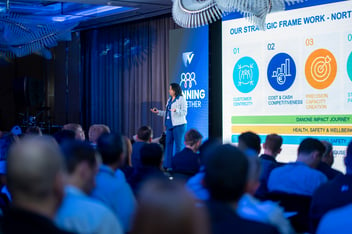11 Key Components of Successful Event Management in 2025
Introduction
Event management in 2025 isn’t just about hosting people in a hall. It’s a blend of smart planning, meaningful experiences, and adaptable tools. Today’s successful events combine physical and digital spaces, lean on automation, and aim for impact beyond the event day. Whether you're planning a product launch or a global conference, getting these components right is essential.
This guide is built around real trends and methods that leading professionals use to run seamless events.
💡 Recommended Read : Event Management Trends and Innovations
1. Strategic Goal Setting
Every event should begin with a clear purpose. Whether it's generating leads, educating employees, or building brand awareness, your goals should be specific and measurable. Aligning event objectives with business outcomes helps drive meaningful impact and maximize return on investment.
Example
A company training session may be designed to increase employee productivity by 15% in the span of three months. When the objective is clear, every decision—venue, content, budget—falls into place.
💡Related Blog : What is Event Management?
2. Audience-Centric Planning
Audience expectations are higher than ever. Start by building attendee profiles using past data, surveys, or CRM systems. This helps tailor the experience to what matters most to them. Personalization is no longer optional. From AI-based content suggestions to segmented invitations, your guests should feel the event was built with them in mind. Use tools that allow tracking of preferences, behavior, and feedback—even before the event begins.
3. Budgeting and Financial Control
Budgeting has gone digital. Platforms like Cvent or Bizzabo help plan, monitor, and adjust in real time. For hybrid events, dynamic budgets are critical—allocating funds based on physical vs. virtual audience needs.
Example
Include contingency buffers and forecast your ROI. For instance, if your goal is lead generation, calculate the cost per lead and potential customer lifetime value before the event starts.
4. Venue and Format Optimization
In 2025, the format must stay flexible. Pick venues that are compatible with both live attendance and virtual participation. Look for tech-ready spaces with reliable Wi-Fi, AV support, and hybrid broadcasting capabilities.
Venue contracts can now include smart terms—like auto-adjustment clauses for attendance changes. These platforms enable faster bookings, easy cancellations, and instant access to availability updates.
💡 Recommended Read : How to Choose the Perfect Venue for Any Event
5. Logistics & Operations
Behind every smooth event is a strong operations plan. This includes scheduling, vendor coordination, transport, signage, on-site staff, and backup resources.
Example
Checklists and task automation tools can reduce human error. For example, load-in/load-out timing, speaker rehearsals, and guest arrival patterns should be mapped in advance.
6. Technology Integration
Modern events run on tech. Use planning tools that offer agenda builders, speaker coordination, and schedule automation.
Engage your audience with immersive tools. AR/VR booths, 3D product demos, and virtual networking lounges create unique experiences. On the operational side, RFID badges or NFC wristbands help with smooth check-ins and real-time tracking of attendee flow.
7. Marketing and Promotion Strategy
Promotion starts early and spreads across channels. Use email, social media, paid ads, and influencer tie-ins to build interest.
SEO is just as important—optimize your event pages to show up for relevant searches. During the promotion phase, countdowns, teasers, and early bird incentives can drive faster registrations and online buzz.
8. Team Roles and Communication
Clear roles prevent confusion. Define who handles what—from tech setup to guest check-in. Remote tools like Slack or Asana help everyone stay aligned, especially when teams are spread across time zones.
Create escalation plans so problems can be resolved quickly. Even small delays or miscommunications can snowball on event day if not handled right.
9. Guest Experience and Engagement
A memorable event keeps the audience engaged from start to finish. That means interactive sessions, real-time feedback tools, and moments of surprise.
Gamification, Q&A sessions, polls, and social shout-outs are simple but effective. Mobile apps can help personalize the journey, offer live updates, and collect quick feedback.
10. Risk Management and Compliance
Risk planning is non-negotiable. Ensure health, safety, and legal requirements are addressed—especially for large public or hybrid events.
Comply with data protection rules (like GDPR), have insurance in place, and prepare legal waivers for speakers or vendors. Don’t forget to build a Plan B—especially for tech outages, travel disruptions, or poor weather.
11. Post-Event Analysis and Optimization
What happens after the event is just as crucial as the event itself. Gather data—attendance rates, engagement scores, and survey feedback. Utilize the data to highlight strengths and pinpoint areas that could be improved. Tools like heatmaps, session ratings, or email open rates can show what content people cared about. Apply these insights to refine future events and keep your strategy evolving.
Final Thoughts
Effective event management today demands more than simply strong coordination skills. It’s about understanding people, adapting fast, and using the right tools. When you align strategy, experience, and execution, the results speak for themselves. Keep refining your approach, and let each event teach you how to make the next one even better.

